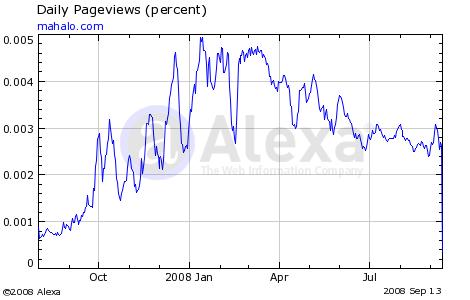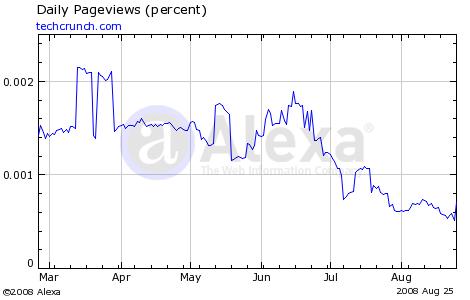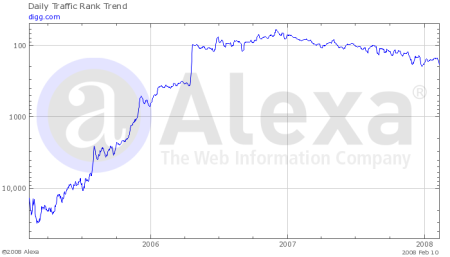We’ve been hard on Mahalo, as we were unimpressed by the idea and the initial execution. However, over time the site has become a useful resource, which is far more than you can say for the vast majority of Web 2.0 startups in the past 18 months. Mahalo is now a vast resources, with tens of thousands of pages on popular topics and a number of well-written “how to” guides. The model may not be innovative, but at first it seemed to be working– the site took off like a rocket from launch, quickly ramping up to become a top 1,000 site on Alexa.
However, since February of this year, the site appears to have been declining or staying flat. What is the cause of this? It may be that Mahalo’s search results in Google are declining. It may be that they’ve simply run out of enough new articles to create that spur interest in searchers. Perhaps the biggest problem is that Mahalo’s top-down model creates very little incentive for users to contribute or interact on the site. This limits the power of the site to drive passionate users and build a community that promotes itself around the web.
Can Mahalo reverse the trend? Absolutely. The site has a ton of traffic, is actually useful, and has the potential to build a real community that can bring the site to new heights. The trick will be to figure out how to create a mutally beneficial relationship between the site’s users and its contributors. The site should focus on ways to create valuable content from its community at a rate that vastly exceeds the current pace.





 We told you from the start that Joose was DOA. Why? It’s not browser-based. If you’re creating anything mass-market right now, it had better be work in a web browser. This isn’t 1999 or even 2003, when apps like Skype or Napster were downloaded in the tens of millions, making people rich and introducing new ideas and new ways to use the emerging network. Ever since the rise of embedded apps, such as YouTube, Google Apps, Webmail, Flash-based games, Scribd, etc., non-browser stuff has been even more useless then it was before.The web is so much more powerful then anything else out there, you’d have to be an idiot not to center your applications in the universal web-access device– the browser. Joost’s website has been down recently, but as
We told you from the start that Joose was DOA. Why? It’s not browser-based. If you’re creating anything mass-market right now, it had better be work in a web browser. This isn’t 1999 or even 2003, when apps like Skype or Napster were downloaded in the tens of millions, making people rich and introducing new ideas and new ways to use the emerging network. Ever since the rise of embedded apps, such as YouTube, Google Apps, Webmail, Flash-based games, Scribd, etc., non-browser stuff has been even more useless then it was before.The web is so much more powerful then anything else out there, you’d have to be an idiot not to center your applications in the universal web-access device– the browser. Joost’s website has been down recently, but as 

 According to Alexa, Digg peaked sometime in late 2007, and has been slipping ever since. Compete and Quantcast show modest gains since late 2007. Which is right? Probably both– Digg’s core audience is over-represented in Alexa’s numbers, and some of them have moved on to other sites, others have gotten older and have less time to spend on the site, and for some the novelty has probably worn off. The slight gains that can be seen on Compete and Quantcast mean that Digg is reaching more mainstream users, which is a plus. However they must be somewhat worried that A. they’re not growing that fast and B. the core demographic appears to be slightly less crazy about the site then they were last year.
According to Alexa, Digg peaked sometime in late 2007, and has been slipping ever since. Compete and Quantcast show modest gains since late 2007. Which is right? Probably both– Digg’s core audience is over-represented in Alexa’s numbers, and some of them have moved on to other sites, others have gotten older and have less time to spend on the site, and for some the novelty has probably worn off. The slight gains that can be seen on Compete and Quantcast mean that Digg is reaching more mainstream users, which is a plus. However they must be somewhat worried that A. they’re not growing that fast and B. the core demographic appears to be slightly less crazy about the site then they were last year.